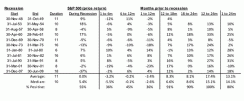By Scott Bauer, for CME Group
At a Glance
- Rising interest rates, inflation and commodity prices are historical signs of an oncoming recession, but the market isn’t seeing any of those yet.
- The stock market typically continues to decline sharply for several months during a recession.
What is a recession and how do equity markets respond to recession indicators? One common definition is two calendar quarters with negative real GDP. According to the National Bureau of Economic Research (NBER), recession is defined as:
“…. a significant decline in economic activity spread across the economy, lasting more than a few months, normally visible in real GDP, real income, employment, industrial production, and wholesale-retail sales.”
A History of Recessions
According to the NBER, there have been seven official U.S. recessions since 1969. Recession indicators have been flashing over the past few months and investors are wondering when will the next recession arrive. Despite the obvious importance of this question, it is impossible to predict this with accuracy and consistency, but we can look back on history to help. We are now in the longest expansion recorded since the end of the Great Recession and many feel that the expansion is long in the tooth and overdone.
History shows us that recessions have occurred for many reasons but typically are the result of imbalances built up in the economy that need to be corrected. These include rising interest rates, inflation and commodity prices as well as anything that hurts corporate profits which may trigger higher unemployment. However, we currently are not seeing these issues: interest rates are near all time lows, inflation is muted, and unemployment is near the lowest in history. So why the fear?
Yield Curve, Etc.
First and foremost is the inversion of the yield curve, or the difference between the yield on 10 year and 2 - year U.S. government bonds. Every instance of the yield on the 2 - year exceeding that of the 10 year has signaled an impending recession, however the timing is questionable. Additionally, a closely monitored index known as the Purchasing Managers’ Index, which is a leading indicator of economic trends in the manufacturing and service sectors just flashed a warning as it slipped into contraction territory. The latest reading pointed to the weakest pace of expansion in the manufacturing sector since September 2009, as new export orders fell at the quickest pace in ten years mainly due to the impending trade war and tariff situation.
Equity Markets Response
So how do equity markets respond to recessions? Stock prices are influenced by many factors. One key issue is the strength or weakness of the underlying economy. When the economy is strong, consumer and business spending increases and corporate profits improve.
Greater profits support higher stock prices. Conversely, when economic activity slows, spending declines, profits are reduced, and stock prices fall. The stock market typically continues to decline sharply for several months during a recession. It historically bottoms out approximately six months after the start of a recession and usually starts to rally before the economy picks up. (See graph, https://www.seeitmarket.com/what-history-says-about-recessions-and-market-returns-17861/)

Not all stocks behave the same during a recession or periods of economic decline. History shows that consumer staples and utilities fare the best because they typically pay higher dividends than stocks in other sectors. Additionally, growth stocks may be the least attractive as they are typically more volatile and tend to trade more directionally with the overall market.






